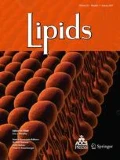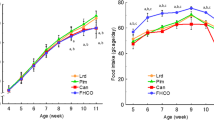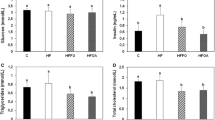Abstract
In recent studies, the life span of stroke-prone spontaneously hypertensive (SHRSP) rats was altered by a variety of dietary fats. It was relatively shorter in rats fed canola oil as the sole source of fat. The present study was performed to find out whether the fatty acid profile and the high content of sulfur compounds in canola oil could modulate the life span of SHRSP rats. SHRSP rats (47 d old, n=23/group) were matched by body weight and systolic blood pressure and fed semipurified diets containing 10% canola oil, high-palmitic canola oil, low-sulfur canola oil, soybean oil, high-oleic safflower oil, a fat blend that mimicked the fatty acid composition of canola oil, or a fat blend high in saturated fatty acids. A 1% sodium chloride solution was used as drinking water to induce hypertension. After consuming the diets for 37 d, five rats from each dietary group were killed for collection of blood and tissue samples for biochemical analysis. The 18 remaining animals from each group were used for determining their life span. The mean survival time of SHRSP rats fed canola oil (87.4±4.0 d) was not significantly different (P>0.05) from those fed low-sulfur canola oil (89.7±8.5 d), suggesting that content of sulfur in canola oil has no effect on the life span of SHRSP rats. The SHRSP rats fed the noncanola oil-based diets lived longer (mean survival time difference was 6–13 d, P<0.05) than those fed canola and low-sulfur canola oils. No marked differences in the survival times were observed among the noncanola oil-based groups. The fatty acid composition of the dietary oils and of red blood cells and liver of SHRSP rats killed after 37 d of treatment showed no relationship with the survival times. These results suggest that the fatty acid profile of vegetable oils plays no important role on the life span of SHRSP rat. However, phytosterols in the dietary oils and in liver and brain were inversely correlated with the mean survival times, indicating that the differential effects of vegetable oils might be ascribed, at least partly, to their different phytosterol contents.
Similar content being viewed by others
Abbreviations
- AAS:
-
flame atomic absorption spectroscopy
- AES:
-
atomic emission spectroscopy
- BUN:
-
blood urea nitrogen
- CO:
-
canola oil
- CHOW:
-
rat chow
- CNO:
-
coconut oil
- FO:
-
flaxseed oil
- HDL:
-
high density lipoprotein
- HOSFO:
-
high-oleic safflower oil
- HPCO:
-
high-palmitic canola oil
- HSFAB:
-
a fat blend high in saturated fat
- LC-PUFA:
-
long-chain (C20+C22) polyunsaturated fatty acids
- LSCO:
-
low-sulfur canola oil
- MIMIC:
-
a fat blend which mimicked the fatty acid composition of canola oil
- MUFA:
-
monounsaturated fatty acids
- PO:
-
palm oil
- PUFA:
-
polyunsaturated fatty acids
- RBC:
-
red blood cells
- SBO:
-
soybean oil
- SBP:
-
systolic blood pressure
- SD:
-
pooled standard deviation
- SFA:
-
saturated fatty acids
- SHRSP:
-
stroke-prone spontaneously hypertensive rats
- TBARS:
-
thiobarbituric acid-reacting substances
References
McLennan, P.L., and Dallimore, J.A. (1995) Dietary Canola Oil Modifies Myocardial Fatty Acids and Inhibits Cardiac Arrhythmias in Rats, J. Nutr. 125, 1009–1013.
Siebert, B.D., McLennan, P.L., Woodhouse, J.A., and Charnock, J.S. (1993) Cardiac Arrhythmia in Rats in Response to Dietary n−3 Fatty Acids from Red Meat, Fish Oil and Canola Oil, Nutr. Res. 13, 1407–1418.
Huang, M.Z., Naito, Y., Watanabe, S., Kobayashi, T., Kanai, H., Nagai, H., and Okuyama, H. (1996) Effect of Rapeseed and Dietary Oils on the Mean Survival Time of Stroke-Prone Spontaneously Hypertensive Rats, Biol. Pharm. Bull. 19, 554–557.
Huang, M.Z., Watanabe, S., Kobayashi, T., Nagatsu, A., Sakakibara, J., and Okuyama, H. (1997) Unusual Effects of Some Vegetable Oils on the Survival Time of Stroke-Prone Spontaneously Hypertensive Rats, Lipids 32, 745–751.
Miyazaki, M., Huang, M.Z., Watanabe, S., Kobayashi, T., and Okuyama, H. (1998) Early Mortality Effect of Partially Hydrogenated Vegetable Oils in Stroke Prone Spontaneously Hypertensive (SHRSP) Rats, Nutr. Res. 18, 1049–1056.
Miyazaki, M., Huang, M.-Z., Takemura, N., Watanabe, S., and Okuyama, H. (1998) Free Fatty Acid Fractions from Some Vegetable Oils Exhibit Reduced Survival Time-Shortening Activity in Stroke-Prone Spontaneously Hypertensive Rats, Lipids 33, 655–661.
Ackman, R.G. (1983) Chemical Composition of Rapeseed Oil, in High and Low Erucic Acid Rapeseed Oils (Kramer, J.K.G., Sauer, F.D., and Pigden, W.J., eds.), pp. 85–129, Academic Press, New York.
Reeves, P.G., Nielsen, F.H., and Fahey, G.C., Jr. (1993) AIN-93 Purified Diets for Laboratory Rodents: Final Report of the American Institute of Nutrition Ad Hoc Writing Committee on the Reformulation of the AIN-76A Rodent Diet, J. Nutr. 123, 1939–1951.
Brooks, S.P.J., Ratnayake, W.M.N., Lampi, B.J., and Hollywood, R. (1998) Measuring Total Lipid Content in Rat Carcasses: A Comparison of Commonly Employed Extraction Methods, J. Agric. Food Chem. 46, 4214–4217.
Thompson, J.N., and Hatina, G. (1979) Determination of Tocopherols and Tocotrienols in Foods and Tissues by High-Pressure Liquid Chromatography, J. Liquid Chromatogr. 2, 327–344.
L'Abbé, M.R., Trick, K.D., and Beare-Rogers, J.L. (1991) Dietary (n−3) Fatty Acids Affect Rat Heart, Liver and Aorta Protective Enzyme Activities and Lipid Peroxidation, J. Nutr. 121, 1331–1340.
Lawless, J.F. (1982) Statistical Models and Methods for Life-time Data, John Wiley, New York.
Ling, W.H., and Jones, P.J.H. (1995) Minireview Dietary Phytosterols: A Review of Metabolism, Benefits and Side Effects, Life Sci. 57, 195–206.
Hopkins, C.Y., Murray, T.K., and Campbell J.A. (1955) Optimum Ratio of Saturated to Unsaturated Fatty Acids, Can. J. Biochem. Physiol. 33, 1047–1054.
Howe, P.R.C., Head, R.J., and Smith, R.M. (1989) High Dietary Sodium Intake Counteracts the Antihypertensive Effect of Fish Oil in Spontaneously Hypertensive Rats, Proc. Nutr. Soc. Aust. 14, 148.
Hobbs, L.M., Rayner, T.E., and Howe, P.R.C. (1996) Dietary Fish Oil Prevents the Development of Renal Damage in Salt-Loaded Stroke-Prone Spontaneously Hypertensive Rats, Clin. Expt. Pharmacol. Physiol. 23, 508–513.
Yamori, Y. (1989) Predictive and Preventive Pathology of Cardiovascular Diseases, Acta Pathol. Jpn. 39, 683–705.
Loeb, W.F., and Quimby, F.W. (1999) The Clinical Chemistry of Laboratory Animals, 2nd edn., Edward Brothers, Ann Arbor.
Sauer, F.D., Farnworth, E.R., Bélanger, J.M.R., Kramer, J.K.G., Miller, R.B., and Yamashiro, S. (1997) Additional Vitamin E Required in Milk Replacer Diets That Contain Canola Oil, Nutr. Res. 17, 259–269.
Bruckdorfer, K.R., Demel, R.A., De Gier, J., and Van Deenen, L.L.M. (1969) The Effect of Partial Replacements of Membrane Cholesterol by Other Steroids on the Osmotic Fragility and Glycerol Permeability of Erythrocytes, Biochim. Biophys. Acta 183, 334–345.
Leiken, A.L., and Brenner, R. (1989) Fatty Acid Desaturase Activities Are Modulated by Phytosterol Incorporation in Microsomes, Biochim. Biophys. Acta 1005, 187–191.
Yamori, Y., Nara, Y., Horie, R., and Ooshima, A. (1980) Abnormal Membrane Characteristics of Erythrocytes in Rat Models and Men with Predisposition to Stroke, Clin. Exp. Hypertens. 2, 1009–1021.
De Mendonca, M., Grichois, M.L., Garay, R.P., Sassard, J., Benlshay, D., and Meyer, P. (1980) Abnormal Net Na+ and K+ Fluxes in Erythrocytes of Three Varieties of Genetically Hypertensive Rats, Proc. Natl. Acad. Sci. USA 77, 4283–4286.
Canessa, M., Adragna, N., Connolly, T., Solomon, H., and Tosteson, D.C. (1980) Na−Li Countertransport Is Increased in Red Cells of Hypertensive Patients, N. Engl. J. Med. 302, 772–776.
Tsuda, K., Ueno, Y., Nishio, I., and Masuyama, Y. (1992) Membrane Fluidity as a Genetic Marker of Hypertension, Clin. Exp. Pharmacol. Physiol. 19 (Suppl. 20), 11–16.
Ooneda, G., Yoshida, Y., Suzuki, K., Kobori, K., Takayama, Y., and Sekiguchi, M. (1978) Smooth Muscle Cells in the Development of Plasmatic Arterionecrosis, Arteriosclerosis, and Arterial Contraction, Blood Vessels 15, 148–156.
Yamori, Y., Horie, R., Ohtaka, M., Nara, Y., and Fukase, M. (1977) Effect of Hypercholesterolaemic Diet on the Incidence of Cerebrovascular and Myocardial Lesions in Spontaneously Hypertensive Rats (SHR), Clin. Exp. Pharmacol. Physiol. (Suppl.) 3, 205–208.
Kroes, J., and Ostwald, R. (1971) Erythrocyte Membranes—Effect of Increased Cholesterol Content on Permeability, Biochim. Biophys. Acta 249 647–650.
Hamano, M., Mashiko, S., Onda, T., Tomita, I., and Tomita, T. (1995) Effects of Cholesterol-Diet on the Incidence of Stroke and Life-Span in Malignant Stroke Prone Spontaneously Hypertensive Rats, Jpn. Heart J. 36, 511.
Yamori, Y., Nara, Y., Tsubouchi, T., Sogawa, Y., Ikeda, K., and Horie, R. (1986) Dietary Prevention of Stroke and Its Mechanisms in Stroke-Prone Spontaneously Hypertensive Rats—Preventive Effect of Dietary Fibre and Palmitoleic Acid, J. Hypertens. 4 (Suppl. 3), S449-S452.
Yamori, Y., Nara, Y., Ikeda, K., Tsuchikura, S., Eguchi, T., Mano, M., Horie, R., and Sugahara, T. (1989) Recent Advances in Experimental Studies on Dietary Prevention of Cardiovascular Diseases, in New Horizons in Preventing Cardiovascular Diseases (Yamori, Y., and Strasser, T., eds.), pp. 1–11, Elsevier Science Publishers, Amsterdam.
Author information
Authors and Affiliations
Corresponding author
About this article
Cite this article
Ratnayake, W.M.N., Plouffe, L., Hollywood, R. et al. Influence of sources of dietary oils on the life span of stroke-prone spontaneously hypertensive rats. Lipids 35, 409–420 (2000). https://doi.org/10.1007/s11745-000-539-5
Received:
Revised:
Accepted:
Issue Date:
DOI: https://doi.org/10.1007/s11745-000-539-5




